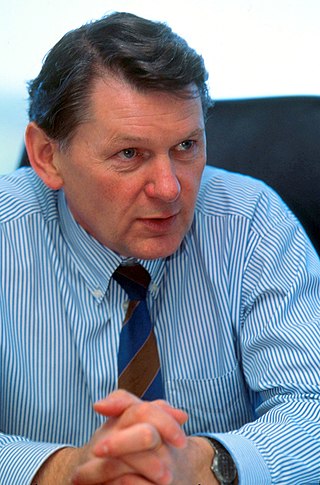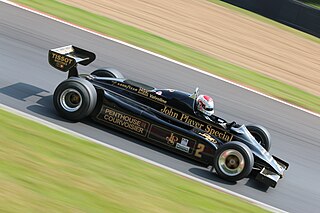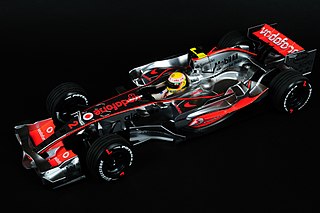Brabham is the common name for Motor Racing Developments Ltd., a British racing car manufacturer and Formula One racing team. Founded in 1960 by Australian driver Jack Brabham and British-Australian designer Ron Tauranac, the team won four Drivers' and two Constructors' World Championships in its 30-year Formula One history. Jack Brabham's 1966 FIA Drivers' Championship remains the only such achievement using a car bearing the driver's own name.

John Edward Barnard is an English engineer and racing car designer. Barnard is credited with the introduction of two new designs into Formula One: the carbon fibre composite chassis first seen in 1981 with McLaren, and the semi-automatic gearbox which he introduced with Ferrari in 1989.
Team Lotus was the motorsport sister company of English sports car manufacturer Lotus Cars. The team ran cars in many motorsport categories including Formula One, Formula Two, Formula Ford, Formula Junior, IndyCar, and sports car racing. More than ten years after its last race, Team Lotus remained one of the most successful racing teams of all time, winning seven Formula One Constructors' titles, six Drivers' Championships, and the Indianapolis 500 in the United States between 1962 and 1978. Under the direction of founder and chief designer Colin Chapman, Lotus was responsible for many innovative and experimental developments in critical motorsport, in both technical and commercial arenas.

The Lotus 49 was a Formula One racing car designed by Colin Chapman and Maurice Philippe for the 1967 F1 season. It was designed around the Cosworth DFV engine that would power most of the Formula One grid through the 1970s. It was one of the first F1 cars to use a stressed member engine combined with a monocoque to reduce weight, with other teams adopting the concept after its success. It also pioneered the use of aerofoils to generate downforce.

The Lotus 79 is a Formula One car designed in late 1977 by Colin Chapman, Geoff Aldridge, Martin Ogilvie, Tony Rudd, Tony Southgate and Peter Wright of Lotus. The Lotus 79 was the first F1 car to take full advantage of ground effects aerodynamics.

The Lotus 88 is an innovative Formula One car designed by Colin Chapman, Peter Wright, Tony Rudd and Martin Ogilvie of Lotus in an effort to maximise the downforce produced by ground effect. The Lotus 88 made its debut at the first practice session of the 1981 season opener, the US Grand Prix West at Long Beach. Although the car was not allowed to race, it was the first car nominally built to Formula One rules to use a carbon fibre monocoque chassis. The carbon fibre McLaren MP4/1 made its debut at the third Grand Prix of the season in Argentina.

The Williams FW07 was a ground effect Formula One racing car designed by Patrick Head, Frank Dernie, and Neil Oatley for the 1979 F1 season.

The Brabham BT49 is a Formula One racing car designed by South African Gordon Murray for the British Brabham team. The BT49 competed in the 1979 to 1982 Formula One World Championships and was used by Brazilian driver Nelson Piquet to win his first World Championship in 1981.

The McLaren MP4/1 was a Formula One racing car produced by the McLaren team. It was used during the 1981, 1982 and 1983 seasons. It was the second Formula One car to use a monocoque chassis wholly manufactured from carbon fibre composite, after the Lotus 88, a concept which is now ubiquitous. The MP4/1 was first entered in a Formula One race at the third grand prix of the season in Argentina.

The Lotus 91 was a car used by the English team Lotus in the 1982 Formula One season, designed by Colin Chapman, Martin Ogilvie and Tony Rudd.

The Arrows A19 was the car with which the Arrows Formula One team competed in the 1998 Formula One season. It was driven by Pedro Diniz, who was in his second season with the team, and Mika Salo, who had moved from Tyrrell to replace Jordan-bound Damon Hill.

The Lotus 99T is a Formula One car designed by Gérard Ducarouge for use by Lotus in the 1987 Formula One World Championship.

The McLaren MP4-22 is a Formula One racing car that was constructed by the Vodafone McLaren Mercedes team to compete in the 2007 Formula One World Championship. The chassis was designed by Paddy Lowe, Neil Oatley, Pat Fry, Mike Coughlan and Simon Lacey, with Andy Cowell and Mario Illien designing the bespoke Mercedes-Benz engine. The car was revealed in testing at Circuit de Valencia in Spain on 15 January 2007, and was driven by double World Champion Fernando Alonso and debutant Lewis Hamilton.

The Lotus 100T is a Formula One car designed by Gérard Ducarouge and Martin Ogilvie for Team Lotus, and used during the 1988 Formula One season. The 100T was an update of the previous Lotus 99T model; technically the car was virtually unchanged, except for redesigned nose and rear bodywork. The car was powered by the same, 640 bhp, 1.5L turbocharged Honda V6 engine that powered the McLaren team to 15 wins in 16 races in 1988. The car was driven by reigning World Champion Nelson Piquet, and Japanese driver Satoru Nakajima.

The Renault RE30 was a Formula One car designed by Bernard Dudot and Michel Tétu for use by the Renault team in the 1981 Formula One season. An updated version, the RE30B, was used in the 1982 season, and a further update, the RE30C, at the start of the 1983 season.

The Renault RE40 is a Formula One racing car. It was designed by Michel Tétu — under the direction of Bernard Dudot, and with aerodynamics by Jean-Claude Migeot — as Renault's car for the 1983 Formula One season.
Gérard Ducarouge was a French Formula One car designer whose career in motorsport started in 1965 when he joined Equipe Matra Sports. His Matra MS80 car, entered by the privateer Matra International team of Ken Tyrrell, won both the Drivers' Championship and Constructors' Championship in the 1969 season. He also designed cars for Ligier and Lotus which won several races in the 1970s and 1980s.

The Benetton B186 is a Formula One racing car, built and raced by the Benetton team for the 1986 Formula One World Championship. It was the first car to be constructed and raced by Benetton, which had bought the Toleman team at the end of 1985 after several years of sponsoring it and other teams, including Alfa Romeo and Tyrrell.
The Lotus Esprit GT1 was a sports racing car produced by Lotus Engineering, a subsidiary of Lotus Cars formed to develop racing cars to compete in the GT1 class racing. It competed in the BPR Global GT Series in the mid 1990s.

The Brabham BT3 is a Formula One racing car. It was the first Formula One design to be produced by Motor Racing Developments for the Brabham Racing Organisation, and debuted at the 1962 German Grand Prix. The Brabham BT3 was the vehicle with which team owner – then two-time World Champion – Jack Brabham, became the first driver ever to score World Championship points in a car bearing his own name, at the 1962 United States Grand Prix. The following year Brabham also became the first driver ever to win a Formula One race at the wheel of an eponymous car, again driving the BT3, at the 1963 Solitude Grand Prix. The BT3 design was modified only slightly to form the Tasman Series-specification Brabham BT4 cars.
















